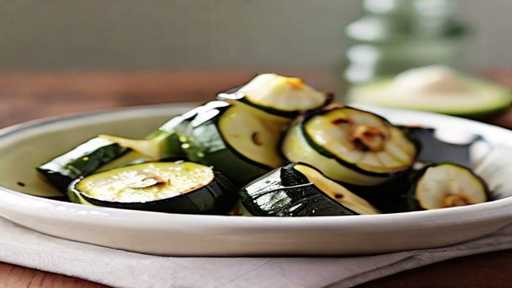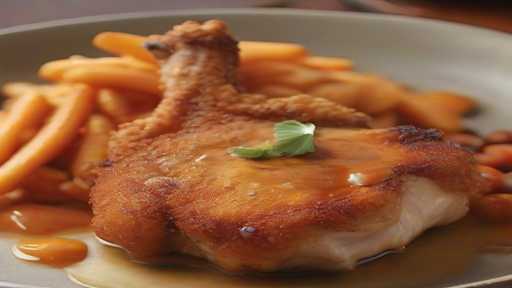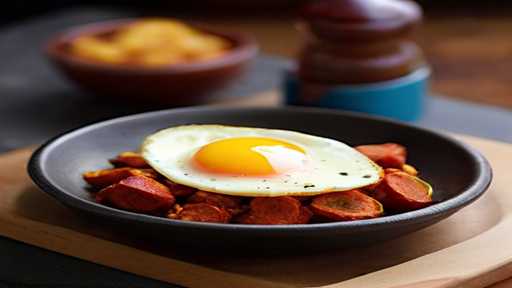How to Make Fresh Brussels Sprouts with Balsamic Coating: A Tasty Curve on an Exemplary Side
Embark on a gastronomic journey with the enchanting charm of Fresh Brussels Sprouts with Balsamic Coating. Take humble Brussels sprouts to a new level with a delicious makeover with a delicious balsamic coating. This Fresh Brussels Sprouts with Balsamic Coating recipe marries the earthy goodness of Brussels sprouts with the sweet tartness of balsamic sauce for a hearty and delicious side dish. Indulge in the vibrant flavors and textures of this delicious creation and discover a simple and sophisticated way to celebrate the natural brightness of Brussels sprouts.
Fresh Balsamic Coated Brussels Sprouts
Fresh Brussels Sprouts with Balsamic Coating originate from Belgium’s rich culinary tradition and embody the essence of European gastronomy. This delicious Fresh Brussels Sprouts with Balsamic Coating dish highlights the versatility of Brussels sprouts, a vegetable from the cabbage family. This recipe’s roots go back to the Brussels region, where farmers were growing this miniature cabbage in the 13th century. The addition of a balsamic coating refines the shoots, giving them a sweet and tangy sheen that perfectly complements their natural earthiness. This dish seamlessly blends history and innovation, giving a delicious twist to timeless vegetables.
Why do fresh Brussels sprouts have a balsamic coating?
Fresh Brussels Sprouts with Balsamic Coating offer a captivating blend of earthy Brussels sprouts and sweet spice in a balsamic glaze. This Fresh Brussels Sprouts with Balsamic Coating recipe turns these cruciferous gems into a delicious side dish by roasting them to perfection. The balsamic coating caramelizes as it cooks, giving the sprouts a deep flavor and highlighting their natural sweetness. The result is a harmonious fusion of textures and flavours, with a crispy outer layer giving way to a delicate interior, all wrapped in the rich, aromatic essence of balsamic. A simple yet sophisticated dish that will complement any dish.
Ingredients: Fresh Brussels Sprouts
- • One pound of freshly cut into halves and trimmed Brussels sprouts
- • 2 tablespoons olive oil
- • 2 tablespoons balsamic vinegar
- • 1 tablespoon honey
- • 1 teaspoon Dijon mustard
- • 2 cloves garlic, minced
- • salt and pepper to taste
- • Two tablespoons of finely shredded Parmesan cheese (for garnish only)
- • One tablespoon of finely chopped fresh parsley (for garnish only)
- Optional Substitutions: Fresh Brussels Sprouts
- • Olive oil: Can be substituted with vegetables. oil or melted butter if desired.
- • Balsamic vinegar: You can also use red wine vinegar or apple cider vinegar instead.
- • Honey: Maple syrup or agave syrup can be used in place of honey.
- • Dijon mustard: You can also use whole grain mustard or regular yellow mustard instead.
- • Parmesan Cheese: Pecorino Romano or nutritional yeast can be used as a vegan alternative.
- • Fresh parsley: Fresh coriander or chives can be used in place of garnish.
- Optional Substitutions: Fresh Brussels Sprouts
Kitchen tools or equipment: Fresh Brussels Sprouts with Balsamic Coating
- 1. Cutting board: Used for trimming and preparing Brussels sprouts.
- 2. Chef knife: An essential tool for chopping and cutting Brussels sprouts.
- 3. Baking tray: Roast the Brussels sprouts evenly in the oven.
- 4. Parchment paper or Silpat mat: Prevents Brussels sprouts from sticking to the baking sheet and makes cleanup easier.
- 5. Mixing bowl: For mixing Brussels sprouts and balsamic coating.
- 6. Whisk: Mix together balsamic vinegar, olive oil, and other glaze ingredients.
- 7. Measuring spoon/measuring cup: For accurately measuring ingredients.
- 8. Brush or spoon: Evenly coat Brussels sprouts with balsamic mixture.
- 9. Garlic Press (Optional): If your recipe calls for garlic, you can easily mince it using a press.
- 10. Oven gloves: Essential for handling hot baking trays when removing them from the oven.
- 11.Tongs: Useful for flipping Brussels sprouts while roasting them.
- 12. Aluminum foil (optional): If desired, you can line the baking sheet with foil for easier cleaning.
Cooking Instructions: Fresh Brussels Sprouts with Balsamic Coating
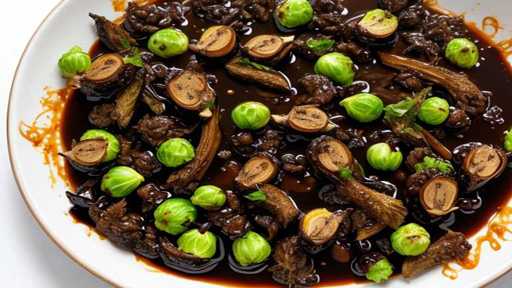
- Directions: Fresh Brussels Sprouts
- 1. Preheat oven to 400°F (200°C).
- 2. Cut the Brussels sprouts in half after trimming the ends. Eliminate any loose or yellow outer leaves.
- Cooking Instructions: Fresh Brussels Sprouts
- 1. Prepare coating: In a small bowl, combine olive oil, balsamic vinegar, honey, salt, and black pepper. This will give your Brussels sprouts a flavorful coating.
- 2. Coat Brussels sprouts. Place the washed and halved Brussels sprouts in a large mixing bowl. Drizzle the balsamic coating over the Brussels sprouts, making sure they are well coated. Stir gently to evenly distribute the mixture.
- 3. Baking: Spread the coated Brussels sprouts in a single layer on a baking sheet lined with parchment paper. Make sure it’s not crowded so it can fry evenly. Roast in the preheated oven until Brussels sprouts are golden brown and crispy around the edges, 20 to 25 minutes. Stir lightly in between so that it cooks evenly.
- 4. Garnish with Parmesan (optional): If desired, sprinkle grated Parmesan over the roasted Brussels sprouts during the last 5 minutes of baking. This adds a delicious flavor.
- 5. Serve: Once the Brussels sprouts are fully roasted, remove them from the oven. b. Transfer to a platter and top with remaining balsamic coating for added flavor.
- Important points to keep in mind: Fresh Brussels Sprouts
- • Be careful with Brussels sprouts during the last few minutes of baking to avoid burning them, especially if you add Parmesan cheese.
- • Adjust to taste with honey, salt, and pepper, as personal tastes may vary.
- • For flavorful results, make sure the Brussels sprouts are well coated with the balsamic mixture.
- • For extra fun, try the optional Parmesan garnish.
Combination of Fresh Brussels Sprouts with Balsamic Coating
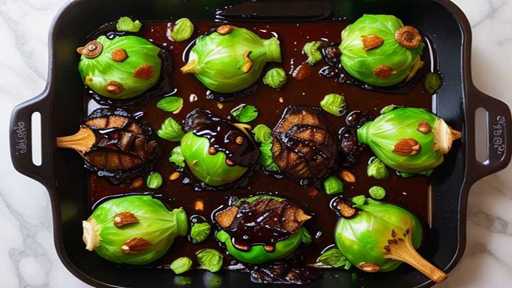
- 1. Grilled Chicken Breast: The tender, slightly smoky flavor of grilled chicken breast is the perfect complement to the protein of Brussels sprouts. A balsamic coating provides a spicy kick and ensures a balanced and satisfying combination.
- 2. Roasted Sweet Potatoes: Roasted sweet potatoes add a natural sweetness and creamy texture that stands out against the crunch of the crunchy Brussels sprouts. A balsamic coating combines these two elements to create a harmonious blend of flavors.
- 3. Parmesan shavings: Sprinkle Parmesan shavings over Brussels sprouts for a rich, nutty flavor. The flavor of the cheese complements the tangy balsamic coating, creating a luxurious combination.
- 4. Toasted Almonds or Pecans: Add toasted almonds or pecans to add a delicious crunch to your dish. The nutty flavor enhances the earthy flavor of the Brussels sprouts, and the balsamic coating brings everything together with a hint of acidity.
- 5. Quinoa or Farro: Serve Brussels sprouts over cooked quinoa or farro for a healthy and hearty meal. The grains absorb the balsamic flavor, creating a hearty and nutritious combination.
- 6. Salmon Fillet: The richness of the salmon goes perfectly with the balsamic-coated Brussels sprouts. Whether grilled or baked, the fish’s natural oils enhance the dish, creating a juicy and flavorful combination.
- 7. Cranberry Compote: For a touch of sweetness and a festive touch, serve Brussels sprouts with cranberry compote. The tart aroma of cranberries complements the balsamic coating, making for a delicious seasonal combination.
- 8. Garlic Mashed Potatoes: Creamy garlic mashed potatoes add a comforting, indulgent dimension to Brussels sprouts. The garlic complements the balsamic coating, and the textures compliment each other for a satisfying cooking experience.
Tips for cooking Fresh Brussels Sprouts with Balsamic Coating:
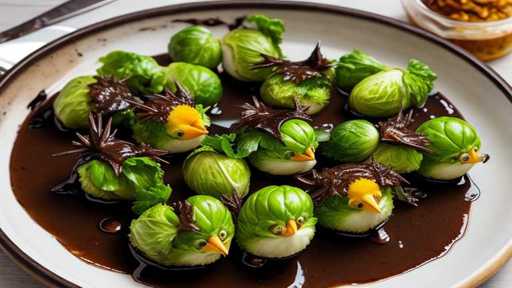
- 1. Choose fresh Brussels sprouts: For the best flavor and texture, choose firm, vibrant Brussels sprouts. Avoid those with yellow leaves or those with a strong cabbage smell.
- 2. Proper Cleaning: Rinse Brussels sprouts under cold water to remove dirt and debris. Remove any yellowing outer leaves and trim the ends.
- 3. Uniform size: Make sure the Brussels sprouts are uniform in size so they cook evenly. This provides a uniform consistency and prevents some sprouts from undercooking and others from overcooking.
- 4. Balsamic Vinegar Grade: For a more nuanced flavor, use a high-quality balsamic vinegar. The acidity and sweetness of the balsamic play an important role in enhancing the flavor of the Brussels sprouts.
- 5. Adjust the balsamic coating: Adjust the amounts of balsamic vinegar and honey to taste. If you prefer a sweeter taste, add a little more honey. If you want a spicier taste, increase the amount of balsamic vinegar.
- 6. Refine with herbs: Experiment with herbs like thyme, rosemary, and garlic powder to add depth to your dishes. Sprinkle on Brussels sprouts before roasting for extra flavor.
- 7. Coat evenly: Make sure the Brussels sprouts are evenly coated with the balsamic mixture. Mix these together in a bowl to ensure each sprout gets a good coating of scent.
- 8. Roasting temperature: Preheat the oven to high temperature (about 400°F or 200°C) to keep the inside tender and the outside crispy. Be careful of the sprouts so they don’t burn.
- 9. Stir while roasting: Stir the Brussels sprouts halfway through the roasting time to ensure even browning. This step caramelizes and crisps each bud.
- 10. Customize to fit dietary restrictions: This recipe is versatile and can be adjusted to suit different dietary needs. For a vegan version, use maple syrup instead of honey. To make it gluten-free, make sure the balsamic vinegar and other ingredients are gluten-free.
Fresh Brussels Sprouts with Balsamic Coating Plating Suggestions:

- Presentation: Fresh Brussels Sprouts
- 1. Perfect presentation: Balsamic coated Brussels sprouts look appealing on a platter or on individual plates. Create a visually appealing presentation that grabs your attention even before you take the first bite.
- 2. Add a delicate garnish: Sprinkle chopped fresh herbs, such as parsley or chives, over the sprouts to add color and extra freshness.
- 3. Drizzle some balsamic vinegar: As a finishing touch, drizzle some balsamic vinegar over the prepared Brussels sprouts. Not only does this add flavor, but it also adds a restaurant-quality sheen.
- Servings: Fresh Brussels Sprouts
- 1. Family Style: Serve Brussels sprouts family style so everyone can feed themselves. This encourages sharing of culinary experiences and encourages interaction.
- 2. Appetizers or Side Dishes: Arrange your dishes as flavorful appetizers or delicious side dishes. Its versatility means it pairs well with a variety of main dishes, from fried chicken to grilled salmon.
- 3. Pairing options: Consider serving balsamic-coated Brussels sprouts with protein-rich main courses for a balanced and satisfying meal. It is also perfect as a side dish for pasta or rice.
- Additional Tips: Fresh Brussels Sprouts with
- 1. Parmesan Cheese Shavings: Top with delicate Parmesan cheese shavings for extra flavor. The nutty flavor of Parmesan cheese complements the sweetness of the balsamic-coated bean sprouts.
- 2. Roasted nuts: For extra crunch, sprinkle roasted nuts, such as sliced almonds or pine nuts, over Brussels sprouts. This not only adds texture to the dish, but also complexity.
- 3. Citrus zest: Add a pinch of citrus zest, such as lemon or orange, to taste. Citrus notes provide a refreshing contrast with the rich balsamic coating.
Fresh Brussels Sprouts with Balsamic Coating Storage and Leftovers:

- Storage: Fresh Brussels Sprouts
- 1. Refrigerate: Allow leftover Brussels sprouts to cool to room temperature before storing in the refrigerator. To keep freshness intact, store in an airtight container.
- 2. Separation: If possible, store balsamic coated Brussels sprouts separately from accompanying sauces and toppings to prevent them from becoming soggy.
- Reheat: Fresh Brussels Sprouts
- 1. Oven method: For optimal crispiness, preheat oven to approximately 375°F (190°C). Spread the Brussels sprouts on a baking sheet and cook for 10 to 15 minutes, or until cooked through and slightly crispy.
- 2. Stovetop: Heat a nonstick frying pan over medium heat. Add Brussels sprouts and cook, stirring occasionally, until heated through. This method helps retain some of the original texture.
- 3. Microwave: If you don’t have time, microwave the Brussels sprouts in a microwave-safe bowl. Start at 30 second intervals, checking and stirring for doneness at each interval.
- Note: Brussels sprouts can be drizzled with a little water or balsamic vinegar to keep them moist when reheating.
- Enjoying Leftovers: Fresh Brussels Sprouts
- 1. Salads: Cold leftover Brussels sprouts are a delicious addition to salads. Simply cut into small pieces and add to your favorite salad for added flavor and texture.
- 2. Side dish: Reheat and serve as a side dish to another meal. It goes great with a variety of proteins such as chicken, fish, and tofu.
- 3. Snack: Served cold or warm, these Brussels sprouts are a satisfying and healthy snack. You can enjoy it even more by combining it with dipping sauces such as yogurt or hummus.
Fresh Brussels Sprouts with Balsamic Coating Nutritional Information:
- Serving Size: 1 cup (approximately 88 grams)
- Calories: approximately 45 kcal
- Fat: 0.5 grams
- • Saturated Fat: 0 grams
- • Trans Fat: 0 grams
- Cholesterol: 0 Milligrams
- Sodium: 20 milligrams
- Total Carbohydrates: 9 grams
- • Fiber: 3 grams
- • Sugar: 2 grams
- Protein: 3 grams
- Vitamins and Minerals:
- • Vitamin A: 15% of Daily Value (DV)
- • Vitamin C: 120% DV
- • Calcium: 4% DV
- • Iron: 6% DV
- • Potassium: 8% DV
- Note: Nutritional values are approximate and may vary depending on specific ingredients and cooking methods .
Variations: Fresh Brussels Sprouts
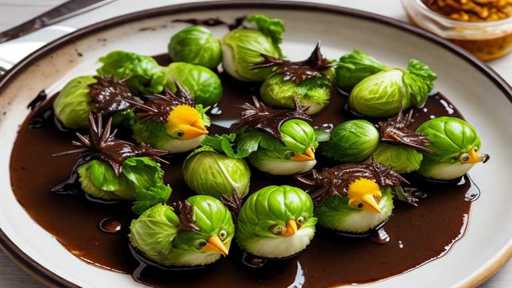
- 1. Maple Glazed Brussels Sprouts: Substitute a maple glaze for the balsamic coating to sweeten the dish. Add maple syrup, a little Dijon mustard, and a pinch of salt to add a delicious twist to a classic recipe.
- 2. Honey Mustard Infusion: Add flavor to Brussels sprouts by replacing the balsamic coating with a honey mustard dressing. For a flavorful alternative, mix together honey, Dijon mustard, a little olive oil, and a little garlic.
- 3. Spicy Parmesan Crust: Refine your dishes with a hearty Parmesan crust. Before roasting, toss the Brussels sprouts in a mixture of grated Parmesan, breadcrumbs, and Italian herbs. This version adds a layer of crunchy cheese to every bite.
- 4. Asian-style sesame glaze: Brussels sprouts are coated with sesame glaze and shipped to the Far East. Mix together soy sauce, sesame oil, and a pinch of sesame seeds for a rich, umami flavor that pairs beautifully with the natural nuttiness of Brussels sprouts.
- 5. Orange peel for a burst of citrus: Add orange peel to add some citrus freshness to your balsamic coating. The combination of spicy balsamic and bright citrus aromas gives dishes a refreshing touch.
- 6. Spicy Sriracha Kick: If you prefer a slightly spicy flavor, replace the balsamic he coating with a spicy Sriracha glaze. Combine with Sriracha sauce, a touch of honey, and a squeeze of lime for a bold, fiery version.
- 7. Mediterranean Herb Blend: Enjoy the flavors of the Mediterranean by tossing Brussels sprouts in a blend of olive oil, lemon juice, minced garlic, and fresh herbs such as rosemary and thyme. This variation gives the dish a light herbal flavor.
Recipe notes:
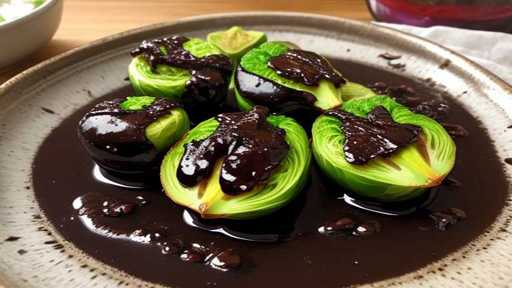
- 1. How to choose Brussels sprouts: When choosing Brussels sprouts for this dish, choose fresh, firm, bright green varieties. Smaller buds tend to be sweeter and more tender. Before cooking, trim the ends and remove any discolored outer leaves.
- 2. Balsamic Glaze: The balsamic coating gives Brussels sprouts a sweet and spicy flavor. For the best flavor, be sure to use a high-quality balsamic vinegar or balsamic vinegar. You can also try flavorful balsamic glazes, such as fig or pomegranate glazes, to add even more complexity to your dishes.
- 3. Roasting time: Pay attention to the roasting time to achieve the desired texture. Overcooking can make your Brussels sprouts too crunchy, and overcooking can make them too tough. Aim for a golden exterior and delicate interior.
- 4. Customization: Get creative with additional materials. You can also add chopped nuts such as walnuts or almonds for crunch, or sprinkle grated Parmesan over the sprouts during the last few minutes of roasting for added flavor.
- 5. Cultural Insight: Although Brussels sprouts are not traditionally associated with any particular culture, they are popular in a variety of cuisines around the world. The balsamic coating brings out the natural sweetness of the bean sprouts, making them a versatile and elegant side dish that goes well with a variety of dishes.
- 6. Serving Suggestions: This dish pairs well with a variety of main courses, from roasted chicken to grilled salmon. It’s also a great addition to your holiday menu, bringing a pop of color and flavor to your table.
- 7. Preparation: To save time, clean and halve the Brussels sprouts ahead of time. Store in an airtight container in the refrigerator until you are ready to fry. This is especially helpful when preparing for busy weeknight dinners or large gatherings.
- 8. A personal touch: Share your love for Brussels sprouts with family and friends by incorporating this dish into your gatherings. Share how you discovered or adapted the recipe to create a personal connection to this simple but flavorful side dish.
In summary, making fresh balsamic-coated Brussels sprouts is a culinary endeavor that transforms this humble green sprout into a delicious and sophisticated dish. This recipe celebrates the natural flavor of Brussels sprouts by infusing them with the sweet and spicy flavor of a balsamic coating. The result is a side dish that’s easy to prepare and satisfying for your taste buds.


